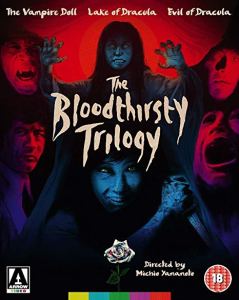A while ago – my reviews this year have been scattershot at best – I wrote a quick piece on The Vampire Doll, an odd Japanese horror film from 1970 that was the first of three loosely related, vampire-themed films Toho made in the early ‘70s. I didn’t particula rly care for The Vampire Doll, and it took me a while to get around to watching the remaining two films: Lake of Dracula (1971) and Evil of Dracula (1974). Like The Vampire Doll, they’re both directed by Michio Yamamoto, and all three feature a writing credit for Ei Ogawa. Unlike The Vampire Doll, these two films are actually about vampires!
rly care for The Vampire Doll, and it took me a while to get around to watching the remaining two films: Lake of Dracula (1971) and Evil of Dracula (1974). Like The Vampire Doll, they’re both directed by Michio Yamamoto, and all three feature a writing credit for Ei Ogawa. Unlike The Vampire Doll, these two films are actually about vampires!
Continue reading “Review: Lake of Dracula (1971) & Evil of Dracula (1974)”

 t I just
t I just  pretty sure I’ve lost all moral high ground. In
pretty sure I’ve lost all moral high ground. In  humanity had ceded the earth to
humanity had ceded the earth to  closely would it hew to his classic, cult
closely would it hew to his classic, cult  The acquisition of
The acquisition of  That could seem like a reductive description, but
That could seem like a reductive description, but 
 fabulous Bubble-era tax evasion/enforcement comedy
fabulous Bubble-era tax evasion/enforcement comedy  seen; I knew it better from the voluminous stacks of manga sitting unread in my local comic shop than as a movie series. Unlike some of the films I’ve reviewed here that only received a wider release outside of Japan very recently,
seen; I knew it better from the voluminous stacks of manga sitting unread in my local comic shop than as a movie series. Unlike some of the films I’ve reviewed here that only received a wider release outside of Japan very recently,